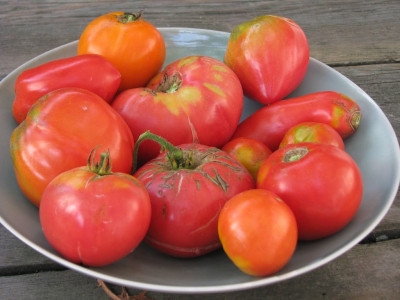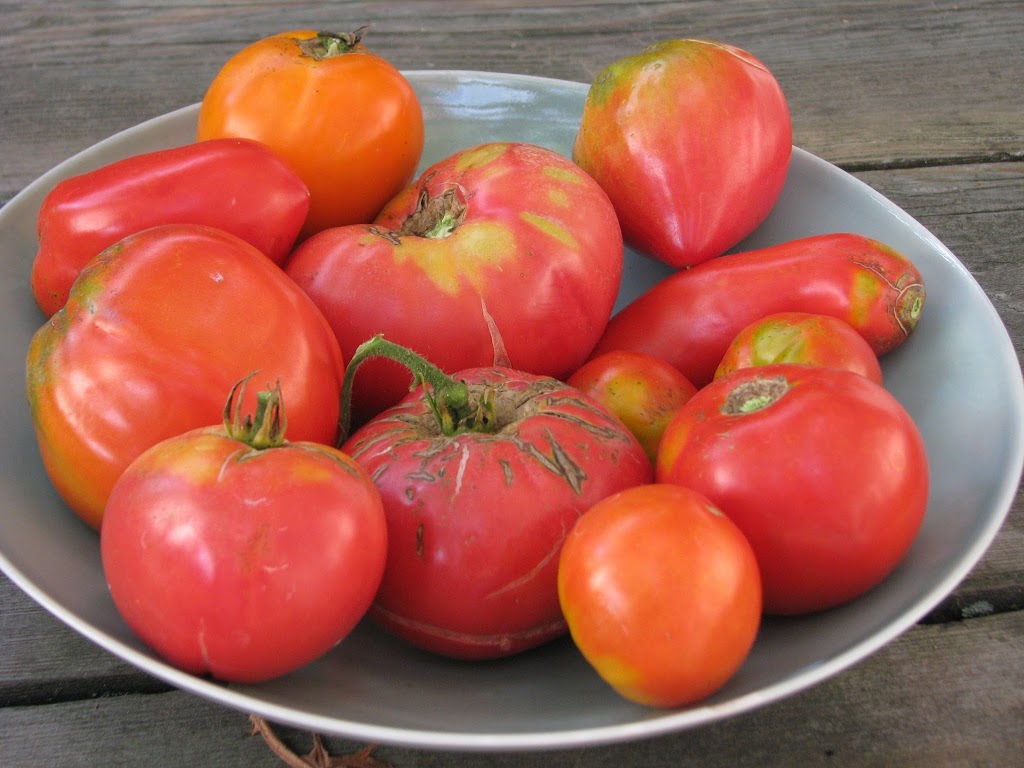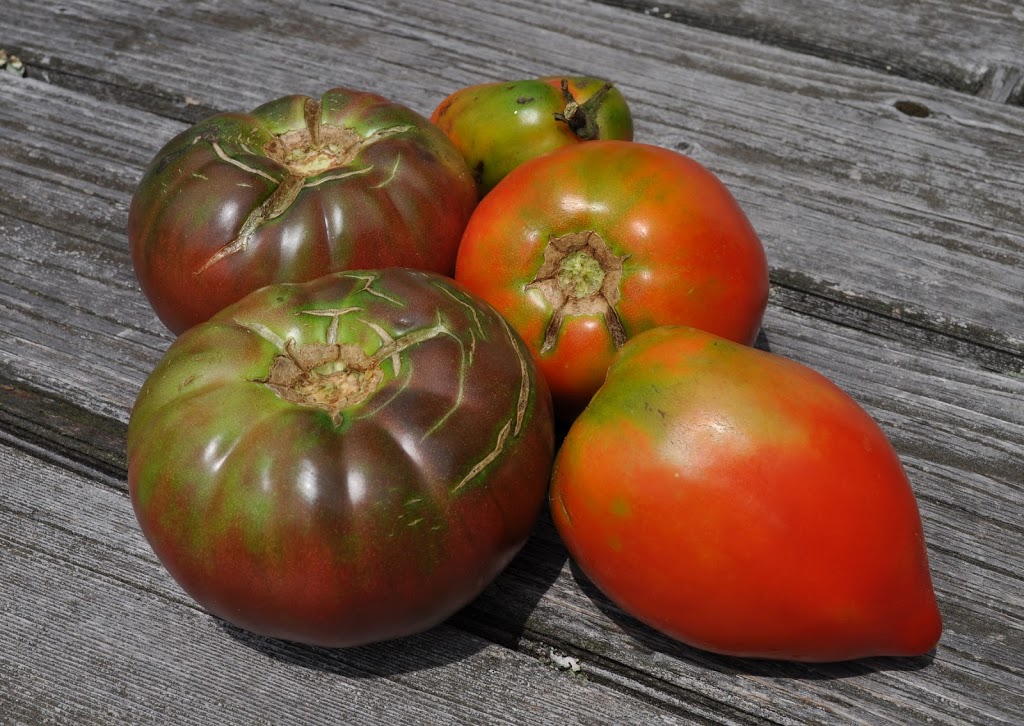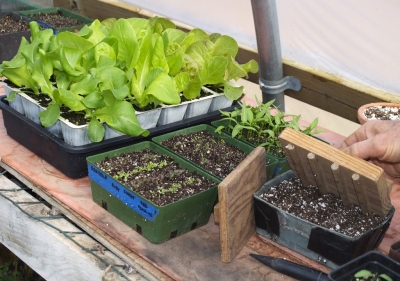And the winner is . . . (drum roll) . . . Lillian’s Yellow. Last week’s tomato growing workshop here climaxed with a tomato tasting of 15 heirloom varieties. Many of the fruits came from Four Winds Farm in Gardiner, NY, which specializes in and, in spring, sells transplants of, heirloom varieties.
In order to be semi-scientific about which heirlooms tasted best, I splayed them out on a tray, and as I sliced each variety, we tasted and rated them on a scale of 1 to 10. Occasionally we went back to tasting prior ones to see if taste buds were getting dulled or if we had started out setting the bar either to high or too low.
Lillian’s Yellow’s victory, with an average rating of 8, came as a surprise. After all, it was up against Brandywine, which is a top contender in every tomato taste-off. Carolyn Male, in her excellent book 100 Heirloom Tomatoes for American Gardens, describes Lillian’s Yellow as having a creamy, yet meaty, flesh and a deep and complex flavor, “rich, citrusy, yet slightly sweet.” Put more simply, it tastes very, very good. This variety is not high-yielding and the fruit often ripens with blemishes and in odd shapes. Still, on the basis of flavor alone, I’ll be planting it next year.

Brandywine, which came in as a close second with an average rating of 7.7, is described by Male, as exploding “with flavor, literally assaulting your senses with every bite, and [having] a depth of flavor that truly matches its century-long heritage.” Brandywine’s close kin, Yellow Brandywine, was no slacker, just missing coming in third. That prize went to the variety Goldie, which averaged 6.7 to beat out Yellow Brandywine at 6.6.
Averages have their limitations. Someone who really really loved Golden King of Siberia, which most people at the workshop disliked for having a soapy flavor, might bring up the average. One eccentric taste bud would be evident in the wide range of the rating. Here, then, is the average and range of ratings for each of the heirloom varieties we tried:
Variety Average Range
Amish Paste 4.2 6
Aunt Ruby 7 4
Belgian Giant 5.3 5
Brandywine 7.7 3
German Johnson 4.8 5
Golden King of Siberia 3.2 5
Goldie 6.7 5
Green Zebra 6.3 5
Lillian’s Yellow 8 2
Mortgage Lifter 6 5
Mountain Princess 4.2 5
Nepal 5.1 4
Rose de Berne 7 2
Truckers’ Favorite 5.8 4
Yellow Brandywine 6.6 4
Take all this with a grain of salt (literally, if you like) because weather also might figure into tomato flavor. And then, of course, it is all a matter of taste.
—————————————————
I’m not sure just how much effect weather has on tomato flavor but the effect can be much more dramatic in other ways in the garden. Especially this year’s weather.
How about that heat back in July? I’m blaming it on a poor showing of peppers and a couple of plantings of corn. Peppers are especially finicky about the weather. Blossoms drop without getting pollinated when daytime temperatures rise above 90° in conjunction with nighttime temperatures above 75°, or if nighttime temperatures are below 55°. Sensitivity varies with pepper variety, with hot peppers being more heat (as in weather) tolerant than sweet peppers.
Unfortunately, this year I grew varieties that seem to be temperature sensitive. Most plants are beautifully lush and green, but have few fruits on them. Many fruits have set after the heat wave and won’t have time to reach full, red ripeness.
Corn also had pollination problems, evidenced by ears with too many missing kernels and uneven ripening. Temperatures in the 90s kill the pollen, which is shed from the tassels atop each plant, although
most pollen is shed in the morning before temperatures get that hot. Again, though, nights that are too warm can interfere with corn pollination. Some insect eating the silk at critical stage could also result in incomplete pollination.
Whacky weather can also put tasseling and silking out of synch. Pollen is usually shed beginning two to three days before silks emerge and continues for five to eight days. Dry weather — especially hot, dry weather — slows silk growth but not tasseling so that when silks are finally receptive, there’s not enough pollen around for complete pollination. Complete pollination, where each of the about 1,000 silks of each ear gets some viable pollen so that the kernel to which it is attached can grow, is what leads to plump, full ears.
To keep us in fresh corn from midsummer on, I made four planting of corn, each a couple of weeks apart. Yields from the last two plantings are heavy, so we’ve been eating and freezing corn almost daily.
———————————————-
Getting back to the question of weather and tomato flavor . . . Although a lot of people feel like the effect can be dramatic, no studies have shown that to be the case. True, cloudy weather means less photosynthesis, which translates to less sugars and other flavor components. And yes, quantitative differences in flavor components have been measured by sensitive instruments. And a lot of rain probably does make tomatoes somewhat more watery. But generally, such changes are too small to be noticed by our taste buds.
Except, there is one dramatic, taste-able difference due to weather. If poor fruit set occurs and fewer fruits result, the remaining fruits will taste noticeably better. Which is one reason why determinate varieties of tomatoes, which set all their fruit in a short window of time (good from a commercial standpoint), taste so bad. And why many heirloom varieties, whose harvest is spread over many weeks, taste so good.








